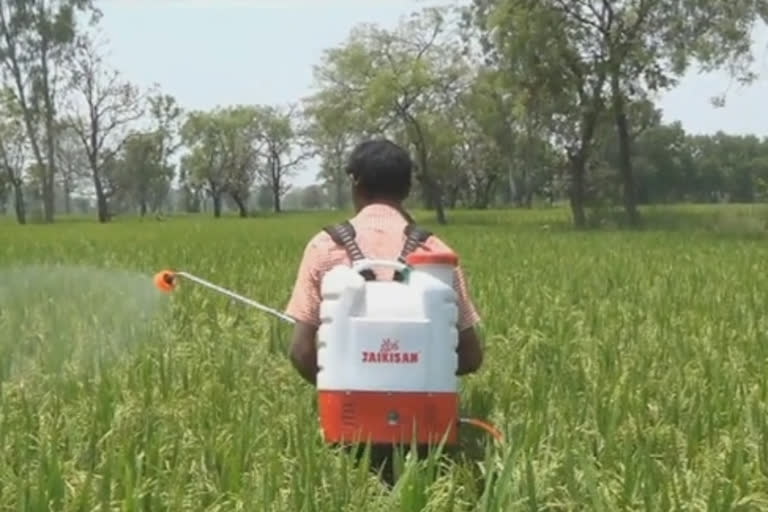Bargarh: Once known as the rice bowl of Odisha, Bargarh district is today infamous for the number of cancer patients, and the number is quite high compared to all other districts in the state.
According to reports, even when state government remains clueless as to why only Bargarh has so many cancer victims, it is suspected that use of a large quantity of chemical fertilizers and pesticides in agriculture is the prime reason behind it.
According to experts, tumour and cancer patients are increasing across the district due to pollution of atmosphere and air, contaminated water and consumption of food with lethal chemical components.
Since 1950, the district witnessed a surge in the cultivation of paddy crops and vegetables, when water from Hirakud reservoir was channelled to irrigate the field through canals. Many farmers from other states such as Andhra Pradesh have settled in the district and started cultivation as availability of irrigation served as an advantage.
The farmers reportedly used fertilizers and pesticides in larger quantities in order to have a better yield of crops. However, without a proper understanding of the side effects of such large scale use, the groundwater reserves in the districts have become polluted year after year.
ALSO READ | Haryana, Punjab farmers in a quandary over pesticide ban
At least 64% of farmers did not use a protective cover such as gloves, boots or even full shirts while spraying pesticides. The use of pesticides reportedly jumped from 440.702 tonnes in 2016 to 713.867 tonnes in 2017.
Moreover, Bargarh gets so much water that farmers sow paddy twice a year, instead of the usual one. In the 2018 Kharif season, of the total 0.34 million hectares (ha) cultivable land, paddy was grown in 0.24 million ha.
Even though some farmers have now begun taking up organic farming, the damage is already gone. The farmers believe that as long as the state government does not bring about a blanket ban, the use of pesticides will continue.
Speaking to ETV Bharat, Lingaraj Pradhan, one of the leaders of farmers organisation in Western Odisha, said that pesticide use is high in Baragarh area and pesticide-cancer links are clearly evident.
"The type of agriculture set in motion following the green revolution in the country made us self-reliant. But the policy has increased our dependence on deadly pesticides to increase the yield," Lingaraj said.
"We need an alternative to current agriculture practices. We farmers are concerned regarding the rise in pesticide-induced cancer. The government, however, needs to bring policy and give us an alternative," he added.
Once agriculture started thriving, many subsidiary industries have come up. Black smoke released form over 100 such rice mills has caused severe air pollution and added to the misery of local residents.
Sources told ETV Bharat that Bargarh district alone has over 130 rice mills!
According to reports, 1017 cancer patients were identified in the district in 2014-15, the numbers increased to 1065 in 2015-16, 1098 in 2016-17 and 1100 in the following year.
ALSO READ | Mango farmers divided over government's pesticide ban in Maharashtra
Among the cancer patients of Bargarh. Peptic cancer and breast cancer cases are more in number, clearing indicating a link between cancer and the food in their plates.
Speaking to ETV Bharat, Roshan Ara Khan one of the residents said that she was diagnosed with multiple myeloma in both her hands and once cancer hit the thoughts were that of eventual death.
"I lost feeling in both my hands. After getting operated at Bhubaneshwar AIIMS and after a period of three months in bed. I was finally cured," she said.
Roshan Ara Khan also experienced severe hardship after getting exposed to radiation therapy, including pain in her knees and changes in the lining of the mouth and the salivary glands causing tooth decay.
Minati Pati, despite not having consumed ‘Ghutka’ or tobacco, was too diagnosed with cancer in the year 2014. She too made a complete recovery.
Prasanna Mishra, who is a journalist by profession, was also suffering from blood cancer. Since the disease was detected at an early date, he was treated at the Tata Memorial Hospital at Mumbai and could be cured successfully. However, they are among the minority who managed to survive cancer.
In the year 2017, the then Bijepur MLA Subal Sahu succumbed to cancer after years of treatment. The Chairman of the Western Odisha Development Council, Subash Chouhan was also diagnosed with cancer and hardly four months after detection, he too breathed his last.
The cancer survivors of Bargarh have joined hands to assist several cancer patients by forming an organisation called “Fighters Group”. This organization has been demanding since 2017 for setting up a cancer hospital at Bargarh.
While the demand for setting up a cancer hospital threatened to turn into agitation against the administration, the state government gave the approval and Indian Council of Medical Research (ICMR), Cuttack was entrusted with the responsibility.
A team of ICMR visited the locality to it has been ascertained that arrangements are being made to provide chemotherapy and radiotherapy treatment facilities for the patients at the newly constructed District Headquarters Hospital at Khedapali.
Odisha is not part of the National Cancer Registry, which systematically collects cancer data. Though Chief Minister Naveen Patnaik recently announced that work on this will begin soon, nothing has happened in this direction so far.
However, the need of the hour is to enforce sweeping changes to the pesticide market and also encourage farmers to go in for organic farming.
ALSO READ | West Bengal tea takes an organic leap



